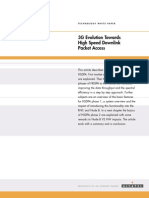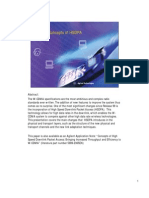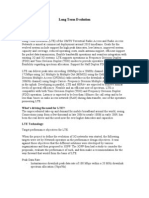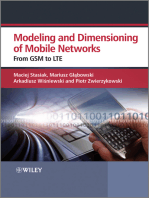Nds Brinzea PDF
Nds Brinzea PDF
Uploaded by
Marvin Nicolas Rivera QuispeCopyright:
Available Formats
Nds Brinzea PDF
Nds Brinzea PDF
Uploaded by
Marvin Nicolas Rivera QuispeOriginal Title
Copyright
Available Formats
Share this document
Did you find this document useful?
Is this content inappropriate?
Copyright:
Available Formats
Nds Brinzea PDF
Nds Brinzea PDF
Uploaded by
Marvin Nicolas Rivera QuispeCopyright:
Available Formats
Improving HSDPA network performance
Building an HSDPA system simulation with OPNET
Marius Brnzea, Supervisor: Meriel Huggard
Introduction
Motivation: HSDPA (High Speed Downlink Packet Access) is a mobile communications protocol that aims to provide mobile, wireless data communication speeds comparable to those of standard wired broadband services Current HSDPA scheduling algorithms are very basic in design and there have been new, more sophisticated algorithms proposed by the academic community. Most of these new algorithms have not been tested in live test-bed scenarios or even with industrial strength simulators; therefore it is very difficult to comment on their performance in a meaningful and critical way.
OPNET model libraries
OPNET Modeler Release 15 - UMTS library Features: Power control, GPRS attach; RLC Modes: AM, UM, TrM; Admission Control Priority handling of data flows based on traffic class at MAC Traffic classes - conversational, streaming, interactive, and background One QoS profile per traffic class of a UE W-CDMA air interface (FDD mode only) CELL_DCH (DSCH / DCH) // CELL_FACH (FACH / RACH) // Logical and transport channels Intra-RNC hard and soft handovers Limitations: GPRS detach QoS Parameters (up/down-link data rates only) QoS negotiation/renegotiation IP Support between RNC and Node-B (only UDP for Iub, IP or ATM) No support for parallel spreading codes on dedicated channel No support for high-speed downlink packet access (HSDPA) No mobility prior to attachment Inter-RNC and inter-SGSN handovers
Research Points: 1. Analyze the UMTS Release 5 specifications in order to distinguish key features that need to be integrated in a valid HSDPA simulation environment 2. Analyze in detail the operation of layers 1 and 2 of the radio interface protocol stack in UTRAN and their implementation in the OPNET UMTS model 3. Identify and describe the key components that require modifications to match the HSDPA 3GPP standard 4. Propose and implement the changes required in a new model library 5. Perform simulation experiments to analyze the behaviour of the proposed changes
HSDPA System Simulator
Implemented features: Eb/No SNR measurement per packet on the DSCH transport channel; CQI value reporting from a UEs MAC to Node-Bs RLC/MAC process in order to accommodate MCS schemas; MAC-hs module in the Node-B process to accommodate various packet schedulers; Thorough analysis of the TTI model and of the data structures for mapping of Transport to Physical Channels; QPSK and 16-QAM capability, fixed SF; Added HSDPA-specific UE Attributes Implementation issues: Highly complex and tightly coupled components;
HSDPA / UMTS Network
UMTS Release 99 TTI = 10, 20, 40, 80 ms Variable SF = 1 256 More transport block per TTI Convolutional code or turbo codes QPSK only Configurable CRC Scheduling in RNC Retransmission in AM RLC Power control Soft hand off
UMTS Release 5 (HSDPA) TTI = 2 ms Fixed SF = 16 One transport block per TTI Turbo codes only QPSK and 16QAM according to UE capability CRC of 24 bits Scheduling in Node B Physical layer retransmissions Adaptive modulation
Hard coded values taken into account for TTI calculation; HARQ process model coded but not implemented;
Future work
Update the HSDPA model library to include: �Multiple code allocation / multiple HSPSDCH physical channels mapped to the HSDSCH transport channel to achieve high downlink speeds (up to 10.8Mbps) �Implement the use of the HARQ module �Change the Transmission Time Interval value for a frame to 2ms, the equivalent of 3 slots �Upgrade the uplink channel to match UMTS R6 specifications (HSUPA) for speeds of up to 5.7Mbps. If implementing HSUPA the following key features need to be implemented: HSUPA unlike HSDPA dont use AMC, instead it uses Turbo coding with QPSK modulation. Power control is used in HSUPA unlike HSDPA HSUPA uses 10ms TTI (and optionally 2ms) HSUPA supports Intra Node B softer and Inter Node B soft HandOver The scheduling in HSUPA is distributed between the UE and the Node B
HSDPA KEY FEATURES Fast link adaptation techniques based on multiple Modulation and Coding Schemes Fast Hybrid Automatic Repeat Request (HARQ) algorithms. Short TTI (2ms) Fast scheduling in the Node-B shares the HS-DSCH among the users
HSDPA protocol architecture, modified parts highlighted
M.Sc. in Computer Science (Networks and Distributed Systems)
You might also like
- From GSM to LTE-Advanced Pro and 5G: An Introduction to Mobile Networks and Mobile BroadbandFrom EverandFrom GSM to LTE-Advanced Pro and 5G: An Introduction to Mobile Networks and Mobile BroadbandNo ratings yet
- 3G Evolution Towards High Speed Downlink Packet Access: Technology White PaperNo ratings yet3G Evolution Towards High Speed Downlink Packet Access: Technology White Paper11 pages
- HSDPA and HSUPA Functional Testing: Simon Binar Tektronix Inc, Protocol Monitoring Division, Berlin, GermanyNo ratings yetHSDPA and HSUPA Functional Testing: Simon Binar Tektronix Inc, Protocol Monitoring Division, Berlin, Germany12 pages
- Hsdpa Principles Seminar: Corrado Carbone - Ro/Qos South100% (1)Hsdpa Principles Seminar: Corrado Carbone - Ro/Qos South146 pages
- 2.1 WRFD-010610 HSDPA Introduction Package: AvailabilityNo ratings yet2.1 WRFD-010610 HSDPA Introduction Package: Availability2 pages
- IRJET AUTOMATED RAB Radio Access BarrierNo ratings yetIRJET AUTOMATED RAB Radio Access Barrier7 pages
- Hsdpa Principles Seminar: Corrado Carbone - Ro/Qos SouthNo ratings yetHsdpa Principles Seminar: Corrado Carbone - Ro/Qos South146 pages
- UMTS Technology and Its Evolution - En.sloNo ratings yetUMTS Technology and Its Evolution - En.slo71 pages
- HSDPA Principles: Prepared By: Legend StaffNo ratings yetHSDPA Principles: Prepared By: Legend Staff50 pages
- UMTS/WCDMA/HSDPA/HSUPA/HSPA+ Technical OverviewNo ratings yetUMTS/WCDMA/HSDPA/HSUPA/HSPA+ Technical Overview36 pages
- UMTS Network Planning and HSDPA Theory Optimization ProceduresNo ratings yetUMTS Network Planning and HSDPA Theory Optimization Procedures35 pages
- High Speed Downlink Packet Access Trends and TechniquesNo ratings yetHigh Speed Downlink Packet Access Trends and Techniques33 pages
- WR - BT1011 - E01 - 0 HSDPA Technology P43No ratings yetWR - BT1011 - E01 - 0 HSDPA Technology P4341 pages
- HSPA - High Speed Packet Access TutorialNo ratings yetHSPA - High Speed Packet Access Tutorial21 pages
- Hiperlan (High-Performance Local Area Network)No ratings yetHiperlan (High-Performance Local Area Network)40 pages
- Empower WCDMA Networks With A HSDPA Solution From ZTENo ratings yetEmpower WCDMA Networks With A HSDPA Solution From ZTE2 pages
- Empirical Validationof Unified Theoryof Acceptanceand Useof Technology ModelNo ratings yetEmpirical Validationof Unified Theoryof Acceptanceand Useof Technology Model17 pages
- Hsdpa For Umts: Stephan Sigg 18.04.2005No ratings yetHsdpa For Umts: Stephan Sigg 18.04.200569 pages
- M.Sc. in Communication and Information Systems Thesis Title: Student NameNo ratings yetM.Sc. in Communication and Information Systems Thesis Title: Student Name26 pages
- Hsdpa: 3G Communications Protocol High-Speed Packet AccessNo ratings yetHsdpa: 3G Communications Protocol High-Speed Packet Access2 pages
- RAS06 Delta Module2 Features & Main ParametersNo ratings yetRAS06 Delta Module2 Features & Main Parameters123 pages
- Hspa (High Speed Packet Access) : Engr. Niño M. Espiritu Engr. John David M. RamosNo ratings yetHspa (High Speed Packet Access) : Engr. Niño M. Espiritu Engr. John David M. Ramos30 pages
- HSPA - Network Optimization & Trouble Shooting v1.2No ratings yetHSPA - Network Optimization & Trouble Shooting v1.215 pages
- HSDPA/HSUPA for UMTS: High Speed Radio Access for Mobile CommunicationsFrom EverandHSDPA/HSUPA for UMTS: High Speed Radio Access for Mobile Communications5/5 (1)
- Modeling and Dimensioning of Mobile Wireless Networks: From GSM to LTEFrom EverandModeling and Dimensioning of Mobile Wireless Networks: From GSM to LTENo ratings yet
- Cisco Certified Network Associate (CCNA) and Cisco Certified Network Professional (CCNP): Mastering Network Automation and Programmability Study GuideFrom EverandCisco Certified Network Associate (CCNA) and Cisco Certified Network Professional (CCNP): Mastering Network Automation and Programmability Study GuideNo ratings yet
- CompTIA Network+ (N10-009) Study Guide: Comprehensive Exam Preparation and Key Concepts for Network ProfessionalsFrom EverandCompTIA Network+ (N10-009) Study Guide: Comprehensive Exam Preparation and Key Concepts for Network ProfessionalsNo ratings yet
- VPN Settings: VPN-Partner A: (GILAT: Router Cisco) VPN-Partner B: (Cliente Gilat: FW Juniper) Network SettingsNo ratings yetVPN Settings: VPN-Partner A: (GILAT: Router Cisco) VPN-Partner B: (Cliente Gilat: FW Juniper) Network Settings1 page
- Evaluation of Signaling Mechanisms To Incorporate Wireless LAN "Hotspots" Into 3G/4G Mobile SystemsNo ratings yetEvaluation of Signaling Mechanisms To Incorporate Wireless LAN "Hotspots" Into 3G/4G Mobile Systems8 pages
- Mobile and Broadband Access Networks Lab Session OPNET: UMTS - Part 2 Background InformationNo ratings yetMobile and Broadband Access Networks Lab Session OPNET: UMTS - Part 2 Background Information6 pages

































































